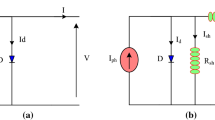Abstract
The structural optimization for a thin film solar cell module based on Cu(In,Ga)Se2 is investigated through numerical simulation and sequential statistical analyses. First, an equivalent numerical model for solar cells is constructed with an electrical circuit consisting of large area diodes and analysis using finite element analysis (FEA). A good agreement in performance characteristic curves between the developed numerical model and practical solar cells is obtained after performing parameter adjustments. To maximize the light conversion efficiency, an optimization technique using the design of experiment (DOE) of orthogonal arrays is employed. The programmed block diagram is used to calculate electric potentials inside solar cell layers and the associated solar performances. Statistical analysis of variance (ANOVA) and F-test are used to discover the dominant design variables (DVs) which are more important on solar cell performances. The second order regression model which relates dominant DVs with solar cell efficiency is mathematically obtained by the employment of response surface model (RSM) and graphically described by the equipotential contour plots.
Similar content being viewed by others
References
S. Goma, K. Yoshioka and T. Saitoh, Effect of concentration distribution on cell performance for low-concentrators with a three-dimensional lens, Solar Energy Materials and Solar Cells, 47(1–4) (1997) 339–344.
H. Stiebig, N. Senoussaoui, C. Zahren, C. Haase and J. Müller, Silicon thin — film solar cells with rectangular — shaped grating couplers, Progress in Photovoltaics: Research and Applications, 14(1) (2006) 13–24.
A. J. Morfa, K. L. Rowlen, T. H. Reilly, M. J. Romero and J. van de Lagemaat, Plasmon-enhanced solar energy conversion in organic bulk heterojunction photovoltaics, Applied Physics Letters, 92 (2008) 013504.
S. Pillai, K. R. Catchpole, T. Trupke and M. A. Green, Surface plasmon enhanced silicon solar cells, Journal of Applied Physics, 101 (2007) 093105.
S. H. Song, K. Nagaich, E. S. Aydil, R. Feist, R. Haley and S. A. Campbell, Structure optimization for a high efficiency CIGS solar cell, 35th IEEE Photovoltaic Specialists Conference (PVSC) (2010) 002488–002492.
A. Hadipour, B. de Boer and P. W. M. Blom, Organic tandem and multi — junction solar Cells, Advanced Functional Materials, 18(2) (2008) 169–181.
I. Repins et al., Characterization of 19.9%-efficient CIGS absorbers, 33rd IEEE Photovoltaic Specialists Conference (PVSC) (2008) 1–6.
A. Dhingra and A. Rothwarf, Computer simulation and modeling of graded bandgap CuInSe2/CdS based solar cells, IEEE Transactions on Electron Devices, 43(4) (1996) 613–621.
M. Burgelman, P. Nollet and S. Degrave, Modelling polycrystalline semiconductor solar cells, Thin Solid Films, 361 (2000) 527–532.
D. D. Nguyen and B. Lehman, Modeling and simulation of solar PV arrays under changing illumination conditions, IEEE Workshops on Computers in Power Electronics (2006) 295–299.
J. Nelson, The physics of solar cells, Imperial College Press, 2003.
L. Han, N. Koide, Y. Chiba and T. Mitate, Modeling of an equivalent circuit for dye-sensitized solar cells, Applied Physics Letters, 84 (2004) 2433.
K. L. Chopra and S. R. Das, Thin film solar cells, Springer, 1983.
COMSOL Multiphysics Version 3.4.
A. Luque and S. Hegedus, Handbook of photovoltaic science and engineering, John Wiley and Sons, 2003.
J. Wennerberg, J. Kessler, J. Hedström, L. Stolt, B. Karlsson and M. Rönnelid, Thin film PV modules for low-concentrating systems, Solar Energy, 69(6) (2001) 243–255.
M. Burgelman and A. Niemegeers, Calculation of CIS and CdTe module efficiencies, Solar Energy Materials and Solar Cells, 51(2) (1998) 129–143.
G. Taguchi and A. P. Organization, Introduction to quality engineering: designing quality into products and processes, The Organization, 1986.
G. E. P. Box and N. R. Draper, Empirical model-building and response surfaces, Wiley, 1987.
D. C. Montgomery, Design and analysis of experiments, 5th Edition, Wiley, 2000.
R. H. Myers, D. C. Montgomery and C. M. Anderson-Cook, Response surface methodology: process and product optimization using designed experiments, John Wiley and Sons, 2009.
Author information
Authors and Affiliations
Corresponding author
Additional information
Recommended by Editor Maenghyo Cho
Ilwoo Seok received his Ph.D in Mechanical Engineering from University of California, Los Angeles (UCLA) in 2010 and is currently serving as an assistant professor at Arkansas State University, USA.
Rights and permissions
About this article
Cite this article
Seok, I., Kim, HJ. & Byun, G. Structural optimization of a Cu(In,Ga)Se2 thin film solar cell using numerical simulation and design of experiment techniques. J Mech Sci Technol 26, 2557–2563 (2012). https://doi.org/10.1007/s12206-012-0637-7
Received:
Revised:
Accepted:
Published:
Issue Date:
DOI: https://doi.org/10.1007/s12206-012-0637-7




